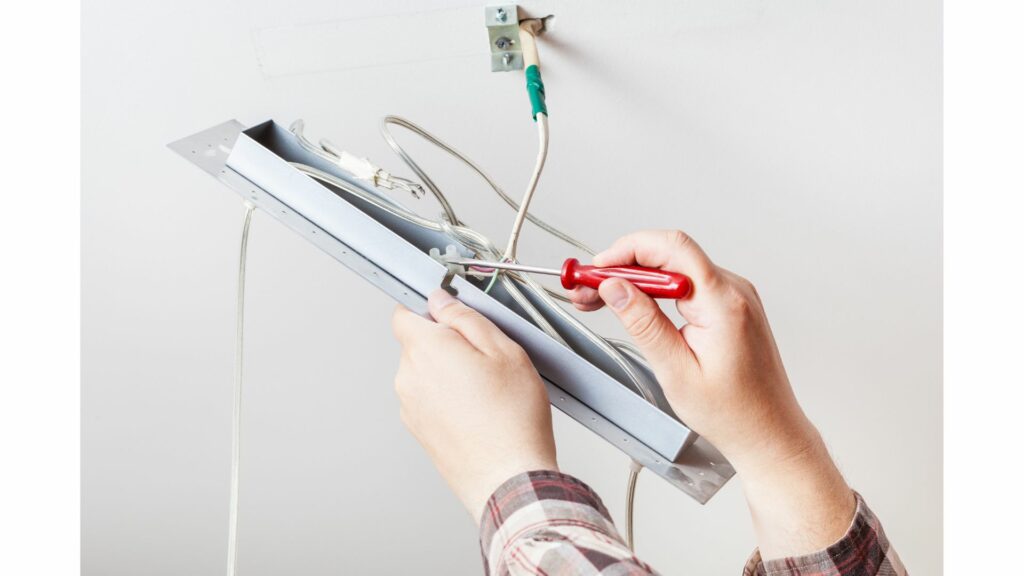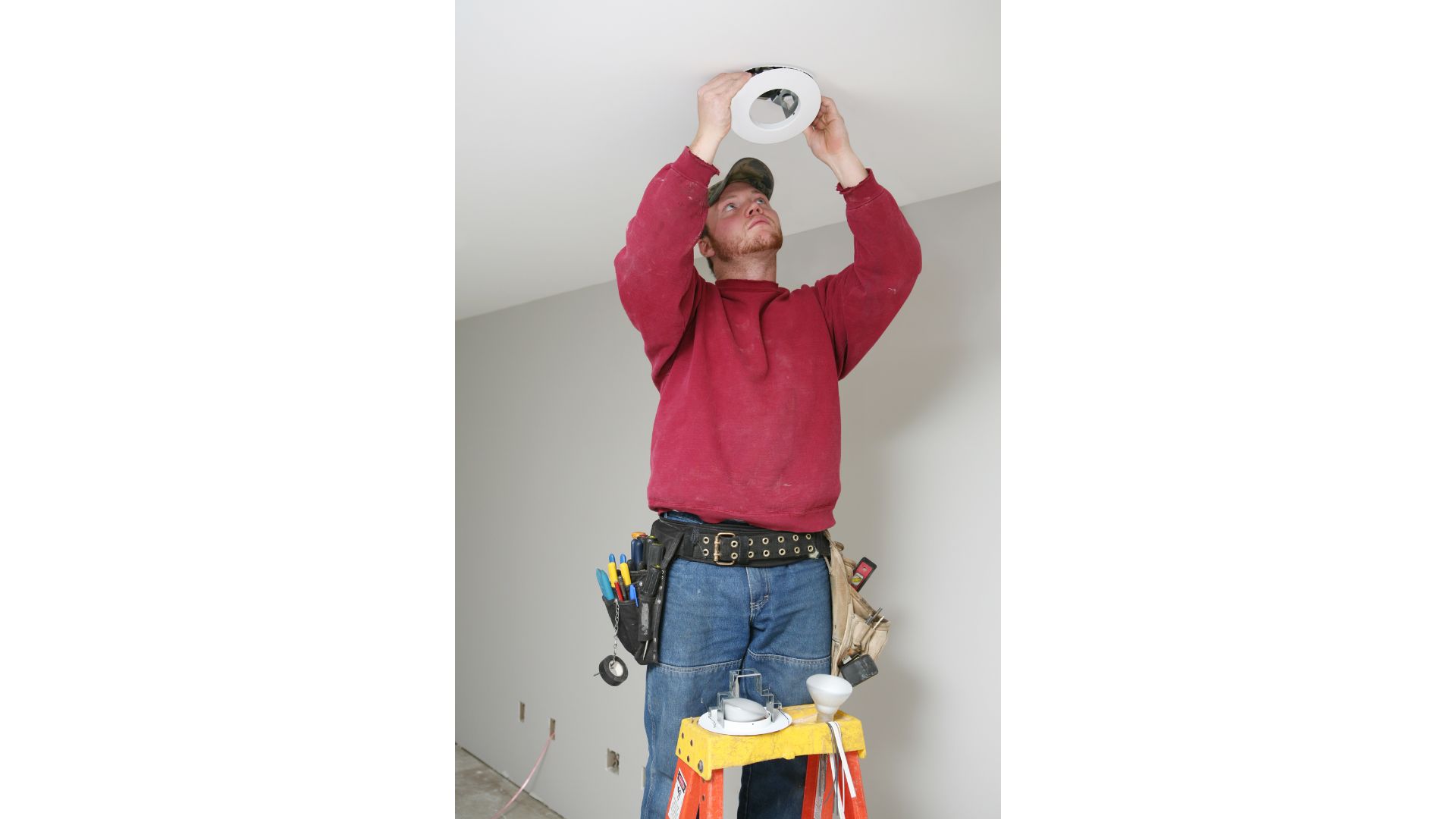You can wire lights with 12/2 wire if the lighting circuit’s total amperage is less than 20 amps. If the total amperage of the lighting circuit exceeds 20 amps, the 12/2 wire will overheat and start a fire.
Contractors use the following steps to identify the correct wire gauge for a particular application:
- Identify the application you want to run and find the wattage. Manufacturers print the wattage on a plate on the device. You can also find this information in the manual.
- Turn the wattage into amps (Watts/Volts).
- Compare the amps to the information in tables like this ampacity wire chart.
- Find the gauge whose amperage exceeds the amps of the device you want to run. Laypeople will look for a matching amperage. But a wire size with a larger amperage leaves room for error. The wire is less likely to overheat and catch fire when a short circuit or surge occurs.
In this case, you already have the gauge (12/2). The question is whether or not it can support your home’s lighting circuit. To answer that question, you must keep the following in mind:
Things To Keep In Mind While Wiring Lights With 12/2 Wire
1). How Many Amps Can 12/2 Gauge Wire Carry?
12/2 wire can carry 20 amps. Some people associate it with 30 amps, but that is only true for a temperature rating of 90 degrees C. The second number (2) has nothing to do with the wire’s thickness. Instead, it refers to the number of conductors in the wire.
In this scenario, you have two current-carrying lines, not including the ground. You can determine a wire’s ampacity by looking at a wire size chart.
2). How Many Amps Do Lights Use?
An incandescent bulb uses 60 watts. Dividing that 60 watts by 120 volts give you 0.50 amps, which is not a lot. Keep in mind that many people use LEDs because of their efficiency.
The average LED consumes roughly 10 watts. However, you are better off using incandescent bulbs to estimate the demands of your lighting circuit. This allows you to determine the maximum load your wires will encounter.
You may settle for a larger gauge than you need, but that is better than buying a smaller gauge than your lighting circuit requires. Naturally, the actual load will depend on the number of lights you have. Multiplying the number of bulbs by 0.5A will give you the lighting circuit’s total amperage.
3). Do You Have A Dedicated or Shared Circuit?
You can trust 12/2 wiring to accommodate a lighting circuit’s electrical demands because most homes use 15A and 20A circuits. Any gauge that supports your home’s 15A or 20A circuit will run the lights without overheating.
The number of bulbs matters. For instance, 12/2AWG wiring can handle a single 0.5A incandescent bulb. But what if you have 50 bulbs? 50 0.5A incandescent bulbs will pull 25 amps if you use them simultaneously, which is more than enough to overwhelm the 12-gauge lines that run a 20A circuit.
What if you have a small home with a handful of lights? You have to worry about the other appliances on the circuit. Many people place lights and outlets on the same circuit. Therefore, even though the 12/2 cabling can handle your lights, any heavy-duty appliance you connect to the circuit via an outlet may overwhelm the wiring.
Therefore, you can’t stop at finding the total amps of the bulbs. Get the wattage of every appliance you expect the lighting circuit to run. You should only install 12/2 wires if the total load (appliances + lights) falls below 20 amps.
4). How Many Lights Can I Wire With 12/2 Wires?
You can add as many lights as you want so long as their total amperage stays below 20 amps.
If each receptacle has a maximum draw of 0.5 amps, you can technically add 40 lights. But because the load cannot exceed 16 amps (80 percent), the practical answer is 32 lights.
Benefits Of Using 12/2 Wire For Light
If you’ve never wired a home, you may wonder why some laypeople question the suitability of 12/2 wires for a lighting circuit. After all, 12/2 wiring works with 20A circuits, and a 20-amp circuit is more than enough to run the lights in a residential setting.
People question the viability of 12/2 wires because contractors typically use 14/2. Therefore, 12/2 is almost overkill. You wouldn’t be wrong in calling the wire size unnecessary. But some electricians use it because the gauge has advantages, for instance:
- 12/2 is less likely to overheat.
- You can use several heavy-duty appliances that 12/2 lines can operate, including dishwashers, power tools, tumble dryers, air conditioners, etc. You don’t have to limit a circuit with 12/2 cables to lights. It can withstand heavier machines.
- 12/2 leaves room for expansion. You can add more lights and appliances in the future if the need arises. This is why consumers use larger sizes than a present load requires. They don’t want to replace the wires in a few years just because the load size has increased. Getting 12/2 instead of 14/2 will save money in the long run.
- 12/2 cables are tough. They can withstand harsh exterior elements such as direct sunlight and abrasion without failing. You can also bury them underground without causing significant harm, especially if you use a conduit.
With all these benefits, why would anyone use 14/2 instead of 12/2? 12/2 is not perfect. The wire size has numerous disadvantages, including the following:
- 12/2 is more expensive than 14/2. It isn’t worth the cost if all you have on the circuit is a few bulbs.
- 12/2 is thicker than 14/2, which makes the wire size more difficult to install.
- Don’t expect push-in terminals to accept 12/2. This forces you to loop the wires around the screws, which is a challenge.
How To Wire A Light With 12/2 Wires?

- Cut the main run of the wire. This assumes that you know the length you need. Leave a one-foot diameter loop.
- Strip the end. Expose ¾ inches of bare copper.
- Connect the conductors from the main run to the wires from the light fixture.
- Cap the wires with a nut.
- Use electrical tape (or a cable tie) to bundle and fasten the wires.
Common Mistakes To Avoid When Wiring A Light Fixture With 12/2 Wire
- Don’t leave open splices. Unprotected wiring is a fire and electrocution hazard. Cover your splices. Use electrical boxes where necessary.
- Don’t cut wires too short. First, it is difficult to make connections with short wires. Secondly, some people make poor connections with short wires. Those connections lead to arcing when they come loose.
- Don’t use the wrong wire size. If you want to add more bulbs and their total amperage exceeds the wire’s ampacity, upgrade to a larger gauge.
- Don’t install light fixtures as a layperson if the local code prohibits you from doing so. The authorities will penalize you.
- Don’t wire light fixtures without the necessary permits (if the law calls for permits).
- Maintain 1 ¼ inches from the edge of the stud while installing nonmetallic sheathed cables to avoid punctures from screws and nails.
- Don’t mix high and low-voltage lines.
- Don’t crowd electrical boxes.
Related post:

